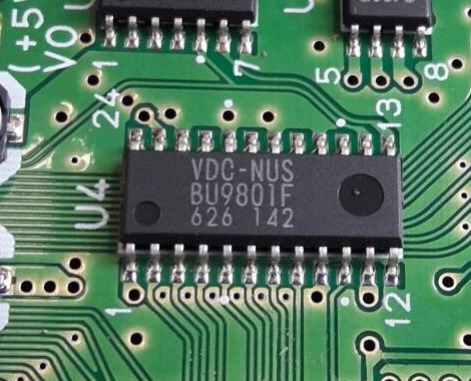CPU | MIPS 64-bit RISC CPU (customized R4000 series) - Clock Speed: 93.75 MHz |
RAMBUS D-RAM 36M bit - Transfer Speed: maximum 4,500M bit/sec. | |
RCP: SP (sound and graphics processor) and DP (pixel drawing processor) incorporated - Clock Speed: 62.5MHz | |
256 x 224 ~ 640 x 45 dots, Flicker-free interlace mode support 32-bit RGBA pixel color frame buffer support, 21-bit color video output, Z buffer, Anti-aliasing Realistic texture mapping: Tri-linear filtered MIP-map interpolation, Perspective correction, Environment mapping | |
Size | Width 260mm (10.23') x Depth 190mm (7.48') x Height 73mm (2.87') - 1.1kg (2.42 lb.) |
Software | Cart based, with a variable size for data that ranges from 32 megabits (4 megabytes) up to 512 megabits (64 megabytes). Save data can be stored internally, in the cart (again with variable sizes) or on a memory card to be inserted in the back slot of the Controllers or in a combination of both. |


Controller
A short video demonstrating a working Nintendo NUS-001 Charcoal Grey Console available at http://stores.ebay.com/AristonSellers. Nintendo 64 Ice Blue Console NUS-001 (USA) Super Clean With Expansion Pack. Model #NUS-001 Released 1996 The Nintendo 64 is a slick looking system if you ask me. It’s dark, smoky gray color and curvy front-end are reminiscent of a classic luxury sports car, IMO.
The Controller for Nintendo 64 has been the most advanced controller so far, possibly also because it was the first to introduce many new elements in the home market. First of all, as one can notice it can be handled in three different postions, and it has been the first to introduce the analog stick (the one in the middle). The first game to use it has been Super Mario 64, this game lets you control the way Mario moves by simply pushing the stick completely in one direction or just by a little: you can walk and run at so many different speeds. Since it has been the first gaming console to introduce the analog stick, designers at Nintendo thought it could be a better idea to leave the orignal 8-way directional pad as the main control way. But as games developed, not many titles use the original control pad; the analog one offers better control in 3d worlds with changing perspective, driving games, rpg games and even platformers, with the possibility to choose the speed of the character.

First introduced by Nintendo 64!
Every way you take the controller in hand you will end up with a trigger at the bottom or on the shoulder of the pad. It has been greatly designed to offer maximum comfort in all 3 postions.

Though the look originates from the old Super Famicom one, some buttons have been removed and other splitted. The most particular one is the yellow C butoon, which is made by four different buttons originating another control pad. This configuration makes possible to move a camera (like Super Mario 64 does - you can change the point of view while running around a mountain and even zoom to Mario's eyes) or to control movement, like in Turok. You cannot imagine how simple is to control a character in a first person view with the Nintendo 64 Controller: holding it like the 3rd example posted here, with the yellow buttons you control the movement on the ground, and with the analog stick you can look and shot freely around while running in another direction. It gives you better and easier control than a mouse and a keyboard, believe me.
Nus-001(usa) Rgb
Ideas behind this controller have surfaced in both Playstation, Dreamcast and now Gamecube, which takes the concept even further by keeping all the good point of the Nintendo 64 one and by adding two accelerator-like buttons at the top.
|
Nintendo 64 Model Nus-001 (usa)
First introduced by Nintendo 64! |
|
Nintendo Nus-001(usa)
First introduced by Nintendo 64! |
|